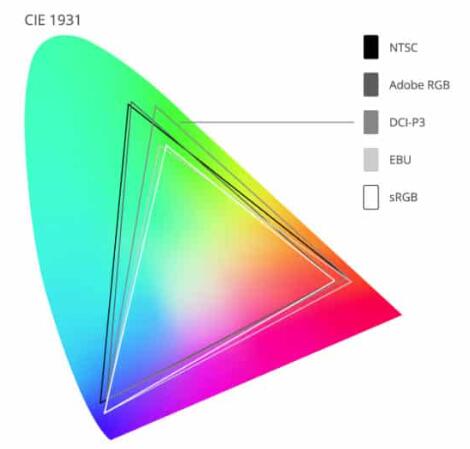sRGB is the standard colour space used for digitally consumed media, including images and SDR (Standard Dynamic Range) video content viewed on the internet. As well as games played under SDR. Whilst displays with a wider gamut than this are becoming increasingly prevalent, sRGB remains the lowest common denominator and the colour space most displays will be able to fully or mostly cover. As such, some will prefer to work within this colour space whether editing photos and videos or developing games. Particularly if the content is to be consumed by a wide audience, digitally.
Adobe RGB is a wider colour space, designed to encompass more of the saturated shades that most photo printers can print. There is significant extension beyond sRGB in the green region of the gamut and green to blue edge, whereas the pure red and blue regions coincide with sRGB. There’s therefore some extension beyond sRGB for intermediate shade areas such as cyan, yellows and oranges. This is a popular choice for those who end up printing photos or where their creations end up on other physical media. Because this gamut can capture more of the saturated shades you might be exposed to in the real world, some prefer to use this colour space even if they don’t end up printing their work. This might be particularly relevant for content creation focused on ‘nature scenes’ with elements such as lush foliage, skies or tropical oceans. As long as the display being used to view the content has a sufficiently wide gamut, those extra colours can be enjoyed.
DCI-P3 is an alternative colour space defined by the Digital Cinema Initiatives (DCI) organization. This is the near-term target which developers of HDR (High Dynamic Range) content have in mind. It’s really an intermediate step towards a much wider gamut, Rec. 2020, which most displays offer limited coverage of. The colour space isn’t as generous as Adobe RGB for some green to blue shades but provides more extension in the green to red and blue to red region. Including for pure reds, oranges and purples. It encompasses a broad range of more saturated shades from the real world that are missing from sRGB. It’s also more widely supported than Adobe RGB, partly because it’s easier to achieve with less ‘exotic’ backlighting solutions or light sources. But also given the popularity of HDR and hardware capability pushing in that direction. For these reasons, DCI-P3 is preferred by some working with SDR video and image content and not just HDR content.
Post time: Nov-29-2022


